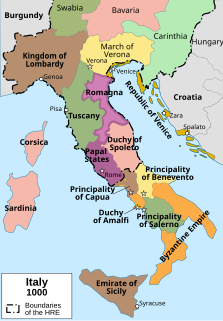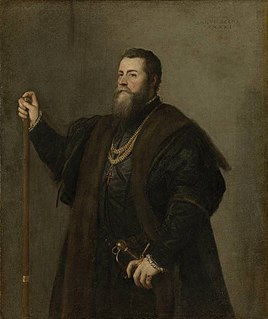
Charles the Short or Charles of Durazzo was King of Naples and titular King of Jerusalem from 1382 to 1386 as Charles III, and King of Hungary from 1385 to 1386 as Charles II. In 1381, Charles created the chivalric Order of the Ship. In 1383, he succeeded to the Principality of Achaea on the death of James of Baux.

The Kingdom of Naples comprised the part of the Italian Peninsula south of the Papal States between 1282 and 1816. It was established by the War of the Sicilian Vespers (1282–1302), when the island of Sicily revolted and was conquered by the Crown of Aragon, becoming a separate kingdom also called the Kingdom of Sicily. In 1816, it reunified with the island of Sicily to form the Kingdom of the Two Sicilies.

The Duchy of Spoleto was a Lombard territory founded about 570 in central Italy by the Lombard dux Faroald. Its capital was the city of Spoleto.

Frederick, sometimes called Frederick IV or Frederick of Aragon, was the last King of Naples of the Neapolitan branch of the House of Trastámara, ruling from 1496 to 1501. He was the second son of Ferdinand I, younger brother of Alfonso II, and uncle of Ferdinand II, his predecessor.

Pedro Álvarez de Toledo y Zúñiga, jure uxoris2nd Marquis of Villafranca del Bierzo was a Spanish politician. The first effective Spanish viceroy of Naples, in 1532–1552, he was responsible for considerable social, economic and urban improval in the city and southern Italian kingdom in general. He was the father-in-law of Cosimo I de' Medici, Grand Duke of Tuscany.

The Duchy of Naples began as a Byzantine province that was constituted in the seventh century, in the reduced coastal lands that the Lombards had not conquered during their invasion of Italy in the sixth century. It was governed by a military commander (dux), and rapidly became a de facto independent state, lasting more than five centuries during the Early and High Middle Ages. The modern city of Naples remains a significant region of Italy, today.
The Dukes of Naples were the military commanders of the ducatus Neapolitanus, a Byzantine outpost in Italy, one of the few remaining after the conquest of the Lombards. In 661, Emperor Constans II, highly interested in south Italian affairs, appointed a Neapolitan named Basil dux or magister militum. Thereafter a line of dukes, often largely independent and dynastic from the mid-ninth century, ruled until the coming of the Normans, a new menace they could not weather. The thirty-ninth and last duke, Sergius VII, surrendered his city to King Roger II of Sicily in 1137.

The Duchy of Sora was a semi-independent state in Italy, created in 1443 by King Alfonso I of Naples and dissolved in 1796. It occupied the south-eastern part of what is today Lazio, bordering what is now Abruzzo. Its capital was first Sora, and later, under the Boncompagni family, Isola di Sora.
Athanasius was the Bishop and Duke of Naples from 878 to his death. He was the son of Gregory III and brother of Sergius II, whom he blinded and deposed in order to seize the throne while he was already bishop.
Sergius I was the first duke of Naples of his dynasty, often dubbed the "Sergi," which ruled over Naples for almost three centuries from his accession in 840 until the death of his namesake Sergius VII in 1137.

The Lombard Principality of Salerno was a South Italian state, formed in 851 out of the Principality of Benevento after a decade-long civil war. It was centred on the port city of Salerno. Although it owed allegiance at its foundation to the Carolingian emperor, it was de facto independent throughout its history and alternated its allegiance between the Carolingians and their successors in the West and the Byzantine emperors in the east.

Castel Nuovo, often called Maschio Angioino, is a medieval castle located in front of Piazza Municipio and the city hall in central Naples, Campania, Italy. Its scenic location and imposing size makes the castle, first erected in 1279, one of the main architectural landmarks of the city. It was a royal seat for kings of Naples, Aragon and Spain until 1815.

Centurione II Zaccaria, scion of a powerful Genoese merchant family established in the Morea, was installed as Prince of Achaea by Ladislaus of Naples in 1404 and was the last ruler of the Latin Empire not under Byzantine suzerainty.
Theoctistus was the Duke of Naples during an ill-recorded period in its history. His reign began sometime around 818 and lasted until 821.

The Capetian House of Anjou was a royal house and cadet branch of the direct French House of Capet, part of the Capetian dynasty. It is one of three separate royal houses referred to as Angevin, meaning "from Anjou" in France. Founded by Charles I of Anjou, the youngest son of Louis VIII of France, the Capetian king first ruled the Kingdom of Sicily during the 13th century. Later the War of the Sicilian Vespers forced him out of the island of Sicily, leaving him with the southern half of the Italian Peninsula — the Kingdom of Naples. The house and its various branches would go on to influence much of the history of Southern and Central Europe during the Middle Ages, until becoming defunct in 1435.

Duke or Duchess San Donato was a noble title, first created in 1602 by the Spanish King Philip III for the Sanseverino family. The duchy was traditionally based on estates and territories held in San Donato di Ninea, Calabria. The first creation, however, lasted only 52 years. In 1668, the title was recreated for a wealthy merchant, Antonio Amitrano, who had some years earlier bought the feudal rights over the former dukes' territories. Descendants of the Ametrano family held the duchy, as one several titles, until it became extinct in the 1970s. There have been successive claims over the centuries by distant kinsmen of the first holders to claim the duchy; these remain unverified.

The County of Apulia and Calabria, later the Duchy of Apulia and Calabria, was a Norman country founded by William of Hauteville in 1042 in the territories of Gargano, Capitanata, Apulia, Vulture, and most of Campania. It became a duchy when Robert Guiscard was raised to the rank of duke by Pope Nicholas II in 1059.

The church of Santi Severino e Sossio and the annexed monastery are located on via Bartolommeo Capasso in Naples, Italy.
Antonio Beccadelli of Bologna (c.1475-1513) was an Italian aristocrat, whose tragic love affair and secret marriage with Giovanna d'Aragona, Duchess of Amalfi, inspired several works of literature, most notably John Webster's The Duchess of Malfi and Lope de Vega's El mayordomo de la Duquesa Amalfi.
Pandulf III was briefly the Prince of Salerno from around 3 to 10 June 1052. He was the eldest of four brothers of Gemma, wife of Prince Guaimar IV. He seized the throne in a coup d'état, when he and his brother assassinated Guaimar. He reigned for only a week before he was forced to step down and was promptly murdered.












